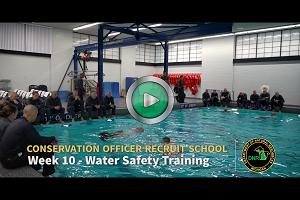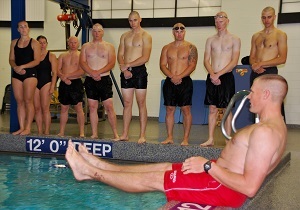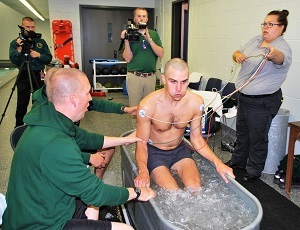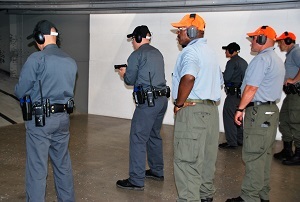Water survival training teaches mind over matter
Week 10: Sept. 17-23, 2017
Recruit School Commander Jason Wicklund knew the truth, but asked anyway. “Are you ready?”
“Yes, sir!” the recruit dutifully replied.
Sgt. Wicklund and his team of instructors knew better. After all, is anyone really prepared for the jarring shock to the  senses that comes with being immersed in a numbing, 36-degree ice bath for four minutes? senses that comes with being immersed in a numbing, 36-degree ice bath for four minutes?
A split-second after sticking his foot in the ice-filled tub, the recruit’s body tensed and his eyes widened. “Keep going,” Cpl. Patrick McManus directed. Once seated, the shivering recruit mustered his composure, but couldn’t conceal his extreme discomfort.
Water survival was on tap during Week 10 of the Michigan Department of Natural Resources Conservation Officer Recruit School, as this brief video shows. On its surface, the training was straightforward: Recruits learned proper methods for rescuing victims in the water and developed skills that can save their own lives. But a deeper dive shows many levels to this week’s subject matter.
Sure, technique is important, as is physical stamina. But so is the mental aspect, which is one reason recruits must endure the ice bath. Thrashing around the water in a panic is a recipe for disaster in real-world conditions. Conservation officers must control their emotions, conquer their fears, block out pain and constructively channel their energy until the job is done. In short, putting mind over matter is one  of a conservation officer’s greatest strengths when confronted with life or death situations on Michigan’s rivers, lakes and streams. of a conservation officer’s greatest strengths when confronted with life or death situations on Michigan’s rivers, lakes and streams.
Different strokes
With Michigan being a four-season state, residents and visitors enjoy the water year-round. From ice fishing and snowmobiling in the winter to swimming and boating in the summer, outdoor enthusiasts flock to water or ice for fun. But being on or near the water increases the risk of accidents, which is why conservation officers spend so much time patrolling waterways.
“Water safety is a very pertinent class in this academy,” Cpl. McManus said. “As conservation officers, we are often first on the scene of water-related emergencies since we work in rural areas and are usually near or on the water. That means our officers must be familiar with the proper and most efficient way to save victims in the water, including themselves.”
Monday’s training began with recruits learning various water-entry techniques, and which would be best in a given situation or body of water. They then went through a series of swimming assessments. Even though recruits had been doing a lot of physical training in the pool – or “tank” as it is referred to – during the past nine weeks, their swimming forms now were being assessed by instructors. doing a lot of physical training in the pool – or “tank” as it is referred to – during the past nine weeks, their swimming forms now were being assessed by instructors.
They were evaluated on the front crawl, the front crawl while rescuing a victim, the breast stroke while rescuing a victim, sidestroke on both their strong and weak sides, and their backstroke. Recruits then were taught different survival floats and techniques for treading water. If that wasn’t enough, they then had to tread water for one hour straight.
After breaking for lunch, the class was back in the tank to practice assisting victims in distress in shallow water. Trainees then learned how to approach and rescue victims in deep water. With those skills well in hand, they practiced techniques to extract an injured or unconscious person from the water.
Off the deep end
Tuesday presented recruits with one of their toughest water survival sessions. They had to jump into the deep end of  the tank in full uniform. They then had to remove their uniforms, let the clothes and utility belts sink to the 12-foot mark, retrieve their gear and put it all back on – all while treading water. The training taught recruits that not only can they tread water longer than they thought, but that they can perform tasks while doing so. the tank in full uniform. They then had to remove their uniforms, let the clothes and utility belts sink to the 12-foot mark, retrieve their gear and put it all back on – all while treading water. The training taught recruits that not only can they tread water longer than they thought, but that they can perform tasks while doing so.
After clearing those hurdles, recruits learned how to turn over and upright a passive victim in the water, and techniques for pulling that victim to shallow water. They also were shown ways to rescue an active and panicking person from drowning.
Just chillin’
But instructors had more plans up their sleeves. One by one, each recruit had to sit in a 36-degree, ice-water bath – up to the neck – for four straight minutes. The bone-chilling exercise allowed them to experience the effects of hypothermia, which always is a danger given Michigan’s climate and abundance of water.
Conservation Officer Shane Webster proved his mettle by volunteering to be first in the tub. His tough, unflinching demeanor set a high bar for recruits who followed.
 With a local EMS crew on-site for safety, recruits were tested on their memory and dexterity skills while sitting in the ice so they could recognize the effects of cold temperatures and understand what happens to their bodies should they ever find themselves in such situations. With a local EMS crew on-site for safety, recruits were tested on their memory and dexterity skills while sitting in the ice so they could recognize the effects of cold temperatures and understand what happens to their bodies should they ever find themselves in such situations.
Cpl. McManus pulled no punches with recruits. “When you’re a conservation officer, it’s not a matter of if you’ll end up in the water, it’s only a matter of when,” he told them.
What a rush
Final water safety evaluations came Wednesday. Recruits were put through a series of physical exercises to get their heart rates up, which simulates an adrenaline rush. They then ran to the training tank area and had to swim to the far end, and swim back to the other end where instructors posing as victims in the process of drowning were positioned. Recruits had to get their “victims” under control, drag them to the far end and back, and pull them from the water.
Wednesday afternoon provided recruits with the small pleasure of putting on dry uniforms and returning to the classroom, where they learned about investigating child abuse and sexual assaults.
Change of pace
Rather than returning to the tank, recruits spent time Thursday on the pistol range, getting acquainted with the Sig Sauer .40-caliber handguns that were issued last week. It was a welcome change of pace from the previous three  days of water safety training. days of water safety training.
After being taught about the sidearm, recruits were taken to the range to learn the techniques that will make them proficient in shooting their pistols.
Emerging with confidence
Learning never stops at the academy. Friday morning was devoted to procedures for responding to civil disorder, a continuation of training begun in Week 7. The afternoon focused the class on how to respond to subjects suffering from mental disorders.
Week 10 was physically grueling. Three straight days in the tank taxed recruits’ limits. But for all the energy they expended in the pool, recruits emerged with something far more important – the self-confidence that comes from knowing they can push through the pain and save lives.
Subscribe to the weekly conservation officer academy blog, which also will be posted on the Michigan DNR Facebook page. View previous blogs from Recruit School #8.
/Note to editors: Accompanying photos are available below for download. Caption information follows.
Different_strokes: Conservation officers must be comfortable in and around water, which is why the academy emphasizes water survival skills. Pictured, Conservation Officer Jason King puts a recruit through his paces as the trainee learns to remove is uniform and put it back on while treading water.
Just_chillin’: Cpl. Patrick McManus, left, and Sgt. Jason Wicklund, Recruit School commander, carefully monitor the condition of Conservation Officer Shane Webster, who showed his mettle by volunteering for the ice bath exercise. The instructors looked for signs of hypothermia, checking Webster’s dexterity after a few minutes of submersion by asking him to move his fingers.
Keeping_his_cool: A recruit struggles to keep his composure while staying submerged in a 36-degree ice bath. The exercise allows trainees to become familiar with the onset of hypothermia, which always is a danger to conservation officers and the victims they rescue on Michigan’s waterways.
Initial_shock: A trainee adjusts to the shock as he enters an ice bath. Recruits must stay immersed in 36-degree water for four minutes. The exercise gives recruits a feel for the early effects of hypothermia and teaches them to deal with the corresponding physical and mental distress.
Finer_points: Recruits listen up as Conservation Officer Joe Deppen illustrates the finer points of water entry and survival techniques.
Pistol_training: Recruits practice loading and firing their Sig Sauer .40-caliber pistols. The handgun is the primary firearm carried by conservation officers./
The Michigan Department of Natural Resources is committed to the conservation, protection, management, use and enjoyment of the state’s natural and cultural resources for current and future generations. For more information, go to www.michigan.gov/dnr.
|


 of a conservation officer’s greatest strengths when confronted with life or death situations on Michigan’s rivers, lakes and streams.
of a conservation officer’s greatest strengths when confronted with life or death situations on Michigan’s rivers, lakes and streams. doing a lot of physical training in the pool – or “tank” as it is referred to – during the past nine weeks, their swimming forms now were being assessed by instructors.
doing a lot of physical training in the pool – or “tank” as it is referred to – during the past nine weeks, their swimming forms now were being assessed by instructors. the tank in full uniform. They then had to remove their uniforms, let the clothes and utility belts sink to the 12-foot mark, retrieve their gear and put it all back on – all while treading water. The training taught recruits that not only can they tread water longer than they thought, but that they can perform tasks while doing so.
the tank in full uniform. They then had to remove their uniforms, let the clothes and utility belts sink to the 12-foot mark, retrieve their gear and put it all back on – all while treading water. The training taught recruits that not only can they tread water longer than they thought, but that they can perform tasks while doing so. With a local EMS crew on-site for safety, recruits were tested on their memory and dexterity skills while sitting in the ice so they could recognize the effects of cold temperatures and understand what happens to their bodies should they ever find themselves in such situations.
With a local EMS crew on-site for safety, recruits were tested on their memory and dexterity skills while sitting in the ice so they could recognize the effects of cold temperatures and understand what happens to their bodies should they ever find themselves in such situations. days of water safety training.
days of water safety training.




